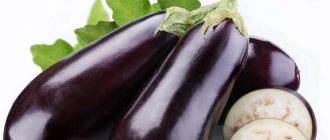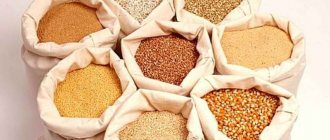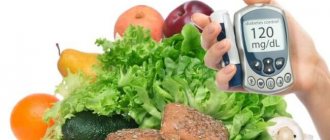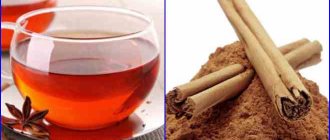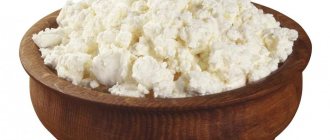Despite the fact that diabetes mellitus is an incurable pathology of the endocrine system, properly organized nutrition can provide a diabetic with a fairly high quality of life. Diabetes diagnosed as type 1 is insulin dependent. The patient's pancreas lacks the ability to produce insulin, the hormone responsible for transporting glucose into the cells and tissues of the body. Treatment of the disease includes regular injections of medical insulin and special nutrition for type 1 diabetes.
Features of the lifestyle of diabetics
Proper lifestyle management in general, dietary changes and dosed exercises allow you to take control of blood glucose concentrations, preventing its serious fluctuations - hypo- and hyperglycemia.
Taking into account all the contraindications for type 1 or 2 diabetes, rationally combining medications, insulin injections with food and drink, and rational exercise, you can reduce the risks of serious complications of the disease, including damage to the kidneys, eyes, cardiovascular system, peripheral nerves and feet.
Initially, it may seem that leading a healthy lifestyle with diabetes is difficult, but in reality, the changes have a very positive effect on the condition, it is not difficult to comply with them, and there are not many real prohibitions and contraindications to certain foods, drinks and actions for diabetes.
A rational diet and regular dosed physical activity as part of a healthy lifestyle for diabetes help:
- maintain stable sugar levels;
- control blood pressure, cholesterol and other plasma lipid concentrations within target parameters;
- reduce body weight and maintain it in a healthy range;
- completely prevent or seriously reduce the risks of complications of the disease.
This allows you to lead a normal life, not suffer from poor health, and have more strength and energy.
Basic principles of proper nutrition
People with diabetes need to change their eating behavior according to the following basic rules:
- eliminate monosaccharides (sweets) and other prohibited foods from the diet;
- observe the drinking regime and eating regime (every 3–4 hours);
- control the calorie content of dishes and the quantitative composition of nutrients;
- exclude from the menu dishes prepared by the culinary method of frying (food should not contain excess fat);
- introduce more vegetables, fruits and berries into the diet;
- limit the amount of salt consumed;
- be sure to have breakfast.
Important! You should stop drinking alcoholic beverages. Beer and wine have a high glycemic index. Strong alcohol puts a strain on the weakened pancreas, and also negatively affects the condition of blood vessels and disrupts the functioning of the heart.
To adjust the diet and start eating right, doctors recommend keeping a “diabetic diary” daily, where the patient notes the amount of food eaten, the composition of the dishes and the time of meal. This will help analyze the dependence of sugar levels on food. Diabetes mellitus, unfortunately, is incurable. If you cannot get rid of a disease, you need to learn to control it. With the help of diet therapy, you can improve your health and minimize the risk of complications.
Nutrition for diabetes
Many are concerned about possible prohibitions and contraindications for consuming certain foods for type 1 or type 2 diabetes. But approaches to nutrition have undergone significant changes over the past 20-30 years, and many of your favorite foods can be eaten, but done less often and in small portions. The basis of nutrition for this pathology is healthy, whole and varied foods containing as few light carbohydrates as possible. The diet is selected individually for each patient, taking into account his preferences and characteristics of the disease.
Among the recommended product groups, certain selection features can be emphasized:
- Non-starchy vegetables - tomatoes, carrots, different varieties of cabbage, peppers, herbs. Starchy vegetables such as peas, potatoes, and corn can be added to the diet in smaller quantities.
- Healthy fruits, even sweet ones, since in addition to sugar they contain fiber, which slows down its absorption.
- Half of the grain diet per day should include whole grains. Processed grains and flour products need to be reduced.
- It is important to consume enough protein - meat, fish, poultry, dairy products.
- The diet should include eggs, nuts, seeds, and legumes.
- Products containing unsaturated fats are beneficial for the cardiovascular system. These are vegetable oils, seeds and nuts, sea fatty fish, avocados. When preparing food, you should avoid frying with butter, lard, margarine, and reduce sour cream and cream to a minimum.
Benefits for patients with diabetes
Endocrinologists recommend including legumes and cereals in your diet several times a week. The best combination with them would be protein foods and vegetables. Diabetics are prohibited from consuming fats. It is better not to add butter to porridge. It is allowed to replace it with a small amount of 10% sour cream.
Cereals are useful for diabetics for several reasons:
- Slow processing of foods by the body allows you to maintain a feeling of fullness for a long period of time. This is a preventive measure against overeating and maintaining stable body weight.
- Grains and cereals, in combination with vegetables, normalize digestion, since such a dish increases the fiber content.
- Despite the simplicity of the dish, porridges are rich in micro- and macroelements and vitamins. The main vitamins are B-group. They are necessary for a patient with diabetes to maintain normal well-being.
Vitamin complexes are prescribed to diabetics as auxiliary therapy. The basis of these drugs is group B.
| Riboflavin | Thiamine | Pantothenic acid | Pyridoxine | Folic acid | Cyanocobalamin |
| AT 2 | IN 1 | AT 5 | AT 6 | AT 9 | AT 12 |
| for proper metabolism and vision | for blood supply | for cell and tissue regeneration | for the nervous system | for sleep | for a normal neuropsychological state |
The variety of minerals, essential amino acids, and polyunsaturated fatty acids depends on the specific type of cereal.
Restrictions for diabetes: foods and drinks
There are a number of foods or certain drinks that should be sharply limited in the diet or completely eliminated. These include fatty foods rich in animal, saturated and trans fats. It is also important to reduce foods that contain a lot of salt, sugar (sweets, sweet pastries), soda and boxed juices, sports energy drinks. It is useful to drink plain water instead of sweet drinks, and use sweeteners when drinking coffee or tea. It is worth sharply reducing the amount of alcohol or completely abandoning it - it provokes sharp fluctuations in blood sugar.
Results
Porridges are healthy and satisfying dishes, the presence of which is necessary in the diabetic menu. When choosing cereals, you need to be guided by the glycemic index value. Diabetics are prohibited from eating semolina porridge, hominy and cereal dishes made from white rice.
The most useful options would be buckwheat, pearl barley, barley, oatmeal, and flaxseed porridge. It is recommended to prepare water-based porridge; replace butter with 10% sour cream. Dishes made from legumes (pea and lentil porridge) can dilute the cereal diet.
Meal schedule
Many people are advised to adhere to a certain diet, eating food at approximately the same time every day. But a more flexible approach to nutrition is also acceptable, depending on the type of diabetes and the medications prescribed to control it. It is important to receive a certain, approximately equal amount of carbohydrate components with each meal. The only thing you can’t do if you have diabetes is fasting for a long time, especially while taking medications or insulin. This threatens the development of hypoglycemia, even coma.
Correctly determined portion sizes are also important to control blood sugar and your weight. You need to discuss the nuances of nutrition with your doctor, use useful smartphone applications that help create a diet for diabetics.
Cereals on the menu for diabetics
Before you start developing a daily menu, you need to find out what kind of cereals a person with diabetes can eat. Only cereals that meet the criteria of the diabetic food basket are allowed in the diabetic diet. In addition, cereals come in different varieties, which also needs to be taken into account when choosing.
Reference! During the cooking process, any cereal absorbs water, which reduces its energy value by 2-3 times.
Buckwheat
Buckwheat comes in two types: crushed and whole grain. In case of diabetes, preference should be given to the kernel. It contains a higher percentage of B vitamins, as well as the following micro- and macroelements:
- potassium and magnesium – are responsible for stable heart function;
- iron – prevents the development of anemia (anemia);
- calcium and phosphorus – support healthy bone tissue;
- zinc and manganese – promote the synthesis of natural insulin.
Buckwheat contains lysine, tryptophan, leucine, and arginine. These are essential amino acids that the body urgently needs, but is unable to produce on its own. The energy value of the kernel is 308 kcal/100 g. Buckwheat boiled in water without seasonings and salt contains 98 kcal/100 g.
In 100 gr. crumbly buckwheat porridge contains 17.1 g. carbohydrates or 1.4 XE. The glycemic index of buckwheat is 55 units, which is beyond the acceptable GI for diabetes. Therefore, it belongs to the category of restricted foods, that is, diabetics should not indulge in buckwheat.
It would be optimal to eat buckwheat twice a week. Buckwheat compares favorably with other grain crops with its high content of vegetable protein (13 g/100 g) and fiber (12 g/100 g).
Buckwheat is good for diabetics
Barley and egg
Pearl barley and barley groats are made from a common cereal crop, barley. Yachka is unpolished crushed grains, pearl barley is peeled grain, devoid of shell. Just like buckwheat, pearl barley and barley are rich in B-group vitamins and contain tocopherol acetate, otherwise known as vitamin E. Its direct purpose is:
- strengthening the immune system;
- increasing the strength of the walls of capillaries and large vessels;
- normalization of blood glucose levels;
- maintaining the skin's regenerative capabilities.
Since cereals are made from the same raw materials, their mineral composition is the same. The difference lies in the quantitative content of micro- and macroelements.
| Microelements | Macronutrients |
| iron, manganese, copper, selenium, zinc fluorine, molybdenum | potassium, phosphorus, calcium, magnesium, sulfur |
The calorie content of the egg is 313 kcal/100 g. Porridge with water contains 76 kcal/100g. The glycemic index of the product is 40 units. The energy value of raw barley is 324 kcal/100g, boiled - 109 kcal/100g. GI is 30 units.
Regarding bread units, per 100 gr. ready-made pearl barley or barley porridge in water accounts for approximately 1.83 XE. Regular consumption of barley cereals helps cleanse the digestive tract of toxins and the body as a whole of toxic deposits.
Semolina and corn
Semolina is a derivative of wheat. Compared to other cereal crops, semolina contains a minimum of dietary fiber and a maximum of carbohydrates. Semolina porridge is quickly processed by the body and causes a rise in blood sugar levels in diabetics.
The calorie content of cereal is 333 kcal/100 g, ready-made porridge – 99 cal/100 g. The glycemic index of porridge without sugar is 75 units. For diabetics, semolina belongs to the prohibited category of food products.
Semolina porridge contains phytin, a substance that interferes with the absorption of calcium and iron.
Corn porridge, otherwise known as hominy, is a filling and low-calorie dish. Raw cereal contains 328 kcal/100 g. In mamalyga – 92 kcal/100 g. Corn grits are rich in beta-carotene, vitamins B3, B5, B6, potassium and phosphorus. Contains arachidonic, linolenic and linoleic amino acids.
The disadvantage of hominy is its high glycemic index – 75 units. For diabetes mellitus, the product is not recommended. Corn flakes are not allowed in the diet. Their GI is 85 units, energy value ranges from 360 to 380 kcal/100 g. (depending on the manufacturer).
Linen
Flaxseed porridge is a dish with a unique chemical composition. It contains a large amount of Omega-3 polyunsaturated fatty acids. There is no need to add butter or sour cream to the porridge. The total fat content is 40 g/100 g.
The flax product is rich in proteins and has a significantly lower carbohydrate component than other cereals. In addition, flaxseed porridge is a leader in dietary fiber content. The vitamin complex is represented by:
- group of vitamins B;
- vitamin E;
- ascorbic acid (vitamin C) is a powerful antioxidant for strengthening the immune system and cleansing blood vessels of cholesterol.
Table of bread units for diabetics
Amount of micro- and macroelements (mg per 100g):
- potassium – 819.6;
- phosphorus – 647.4;
- magnesium - 395;
- calcium 257;
- iron 5.76;
- manganese – 2.52;
- zinc – 4.38.
The composition of nutrients determines the calorie content of the product - 298 kcal/100 g. But the glycemic index does not exceed 35 units. 2 tablespoons (heaped) contain 1 XE.
Oats
Oatmeal is prepared from whole grains or flakes - peeled oats. The vitamin and mineral composition of oatmeal is similar to buckwheat. During industrial processing of grains, cereals lose most of their valuable substances. For example, in terms of the amount of dietary fiber, Hercules oatmeal is inferior even to buckwheat.
In addition, the cereal contains increased carbohydrate content, therefore higher calorie content. Therefore, diabetic patients are recommended to cook porridge from unpeeled oats or the coarsest flakes. The glycemic index of cereals cooked in water is 40 units; when cooked in milk, the figure increases 1.5 times.
Important! Muesli is contraindicated for diabetes; its GI is 80-85 units.
Millet and wheat
These are two different products and should not be confused. Wheat groats are made from durum wheat, millet groats are made from purified millet grains. Wheat contains a large amount of fiber, vitamins B1, B2, B4, B5, B6, B9, potassium, magnesium and phosphorus.
The energy value of raw cereals is 341 kcal/100 g, ready-made wheat porridge is 111 kcal/100 g. The glycemic index of cereal does not exceed 45 units. One unit of bread contains 50-60 grams. cereals (depending on the variety). Considering that wheat boils a lot, a serving of porridge is 100 grams. does not exceed 1.3 XE.
Wheat dishes are available for diabetics due to their low glycemic index
Millet cereal is higher in calories - 378 kcal/100 g. The useful components of the product are vitamins A, E, B-vitamin complex, iron, magnesium, potassium, sulfur, calcium, fluorine, manganese, etc. The main valuable property of millet porridge is its ability to stimulate the production of natural insulin and regulate metabolic processes.
Endocrinologists recommend consuming millet porridge on a regular basis for prediabetes and diabetes. The glycemic index of cereals is 40-50 units. Millet can be cooked in water and 1.5% milk.
Rice
Diabetics need to be extremely careful with rice cereal. Plain white rice has a high glycemic index because it contains a lot of starch and simple carbohydrates. White grains should be avoided. For people with diabetes, brown (brown) and black varieties of rice with a GI of 50 units are allowed on the menu. In 100 gr. Ready-made rice porridge in water contains 2 XE and 110 kcal.
More information about peas and lentils
Peas and lentils are legumes recommended for consumption in diabetes mellitus. Legumes are rich in fiber, a healthy plant protein. Lentils and peas contain vitamins, amino acids, and minerals. Dishes made from legumes make you feel full for a long time.
According to the glycemic index, products belong to the permitted category (GI = 30 units). In terms of energy value, pea porridge contains 84.5 kcal/100 g, lentil porridge – 93 kcal/100 g. For bread units, the approximate content is 1 XE = 60g. ready dish.
Exercise and activity
It is equally important for patients with diabetes to be physically active. Glucose is the main fuel for muscles; due to regular exercise, it is actively consumed, and its level in plasma is maintained lower. In addition, exercise helps maintain overall health and good mood, strengthens the heart and blood vessels, and helps more actively deliver oxygen to tissues.
Physical activity includes traditional exercise such as swimming or playing football. But there is also household activity - you need to move around the house more or use the stairs instead of the elevator. It all matters.
Some people worry that physical activity will be too strenuous or that it will make diabetes management more difficult. And if hypoglycemia occurs frequently, patients worry that their blood sugar will drop sharply. But activity doesn't always lower your blood sugar—it can also cause it to rise.
There is no one activity that is suitable for everyone with diabetes. It's about finding what works best for a particular patient. It is best to combine different activities because they have different benefits. And doing the same thing will get boring after a while.
For example, swimming can increase your breathing and increase your heart rate. This is good for heart health because it has to work harder to pump blood around the body. And if you have diabetes, it's even more important to keep your heart healthy because diabetics are at greater risk for heart disease and other complications. But even gardening helps build strength and can help the body use insulin better.
Diabetic rules for cooking and eating porridge
In order not to provoke an attack of hyperglycemia (increased glucose levels in the blood), porridges for diabetics are prepared in compliance with certain conditions:
- the basis is water or milk with a fat content of no more than 1.5%;
- It is prohibited to add sugar; it is replaced with fresh or frozen berries, dried fruits (except raisins), and nuts;
- it is necessary to wash the cereal to remove excess starch;
- butter is allowed in the compensated stage of the disease, no more than 5 grams. per serving (diabetologists recommend replacing tea oil with 10% sour cream);
- It is better to eat viscous porridge for breakfast;
- It is not recommended to cook oatmeal; they should be brewed with boiling water and left to infuse;
- the volume of the dish cannot be exceeded (a single serving for type 2 diabetes is 200 grams, for type 1 diabetes it is calculated according to XE):
- cereals with a glycemic index of more than 40 are allowed only with stable glycemic compensation (you can lower the GI of the finished dish if you pre-soak the cereal, cook it al dente and cook it until ready, wrapped in a blanket);
- semolina porridge and hominy are excluded from the diet;
- you should choose whole buckwheat grains, unrefined oat grains or coarse oat flakes for cooking;
- Instant porridges should be eliminated from the menu.
As a side dish, cereal dishes go well with boiled (baked) chicken, turkey, and fish. Buckwheat and pearl barley go well with mushrooms. Recipes for making viscous porridges for diabetics differ from traditional recipes in the absence of sugar.
From boyar-style buckwheat porridge, you should exclude the brisket; do not fry vegetables (onions and carrots), but only simmer a little in olive oil. Millet porridge with pumpkin should be avoided, since the dish has a high GI.
On a note! Diabetologists recommend adding a tablespoon of bran to a serving of viscous porridge. This will help speed up metabolism and enrich the dish with minerals and vitamins.
Active lifestyle at home
It is useful to vacuum the house and wash the floors, and clean more often. If you need to start at an easier pace, you can try standing during TV commercials. If you can handle it, try standing for the entire commercial break and then walking in place during the commercial. You can gradually add one type of exercise at a time.
Even a small change in your daily routine (like going for a walk) will increase your activity and help you feel better about living with diabetes. Can:
- get off the bus one stop earlier;
- ride a bike;
- walk.
If you have diabetes, it is very important to stay active at work, especially if you have to sit in front of a computer for long periods of time. Useful:
- climbing stairs;
- walking meetings;
- standing while a person is talking on the phone;
- Chair exercises such as bending and raising your arms.
What sweeteners are allowed?
Sweeteners are sugar substitutes whose production began in the 20th century. Modern drugs are almost harmless. There are two types of sweeteners:
- Natural sweetener (sorbitol, xylitol, stevioside, fructose). Obtained by heat treatment of plants. When they are consumed, the body produces a small amount of energy. You cannot take more than 4 g per day. For diabetes and obesity, a doctor's consultation is necessary.
- Artificial sweetener (aspartame, saccharin). When substances decompose, the human body does not absorb energy. These substitutes are sweeter than glucose, but the calorie content is zero. The drugs are great for people with diabetes.
According to research, sucralose and stevia cannot cause the development of negative reactions. Due to their safety, no processes in the body change after their use.
How exercise affects blood sugar levels
Physical activity can have different effects on blood sugar levels, depending on what the person with diabetes does. Many people don't want to exercise because it lowers their blood sugar. Not all types of exercise lower blood sugar; some cause it to rise. Therefore, it is important to follow a number of rules.
The best time to exercise is one to three hours after a meal, when blood sugar levels may be higher. If a person takes insulin, it is important to check their blood sugar levels before exercise. If your pre-workout level is below 5.5 g/L, eat a piece of fruit or have a small snack to boost your blood sugar and avoid hypoglycemia. Testing again after 30 minutes will show whether your blood sugar levels are stable. It's also a good idea to check your blood sugar levels after any particularly strenuous workout or activity. If the patient is taking insulin, the risk of hypoglycemia may be greatest 6 to 12 hours after exercise. Experts also warn against exercise if a person's blood sugar levels are too high (more than 13.8 g/L) because exercise can sometimes raise blood sugar levels even higher.
Because of the dangers associated with diabetes, a medical alert bracelet should always be worn indicating that the patient has diabetes and is taking insulin. You should also keep glucose lozenges or tablets with you during your workout in case your blood sugar levels drop sharply.
Coffee Recipes for Diabetics
In case of such a chronic disease, it is recommended to drink freshly brewed coffee from natural beans. The most gentle and mild option is beans purified from the active substance caffeine or green coffee - such beans have not been subjected to heat treatment, and drinks based on them have the mildest taste. There are also alternatives to an invigorating drink with a similar taste: chicory, cocoa, Jerusalem artichoke drink.
Jerusalem artichoke coffee
When purchasing fresh Jerusalem artichoke fruits, you need to prepare them before preparing a hot drink.
Ingredients:
- 30 grams of dried Jerusalem artichoke fruits
- A teaspoon of Royal Forest Jerusalem artichoke syrup
- 250 ml water
Cooking steps:
- Grind the required amount of fruit. To do this, cut them with a knife or chop them on a coarse grater.
- Dry the crushed fruits. It is best to do this outdoors or in the sun.
- Fry the dried fruits in a dry frying pan.
- Immediately before preparing a hot drink, grind the dried and roasted fruits in a coffee grinder.
- Place the crushed fruits in a pot and fill with water.
- Cook the drink over low heat until lightly boiling, about 5-7 minutes.
- Add a small amount of Jerusalem artichoke syrup to the finished slightly cooled drink for a sweeter taste.
Cold mochaccino in French
Ingredients:
- 250 ml water
- A teaspoon of ground coffee
- 100 ml skim milk
- 2 tbsp. l. Royal Forest cocoa powder
- crushed ice
Cooking steps:
- Place the ground grains in a Turk and fill with water.
- Simmer the drink over low heat for about 3 minutes.
- Add cocoa powder to the Turk, continue to cook the drink until ready, about 4 minutes.
- Pour the hot drink into a glass, let it cool, add milk and ice.
Possible options
To avoid difficulties in choosing products, it is advisable to develop a menu for 7 days. You can simply swap dishes as needed. Seven diabetic breakfasts:
- omelette with Adyghe cheese, cooked in the microwave;
- wheat porridge in water, with the addition of 10% sour cream (1 tbsp);
- oatmeal milk porridge with the addition of fresh berries (fruits);
- cottage cheese casserole with cinnamon and apples;
- buckwheat porridge with milk (fat content 2.5%);
- whole grain bread with Adyghe cheese and 2 soft-boiled eggs;
- toast with curd paste and fresh cucumber.
On a note. A simple recipe for curd paste: 2% fat cottage cheese needs to be punched in a blender, add chopped herbs, a little salt and spices.
Recommended soups for type 2 diabetes:
- fish soup (it is ideal to prepare this dish by combining fatty and lean varieties of fish);
- mushroom soup (you can use dry, fresh or frozen mushrooms);
- bean or lentil soup in chicken broth with herbs and vegetables;
- frozen seafood soup;
- lean cabbage soup;
- soup of sorrel and beet tops in weak beef broth;
- chicken broth with meatballs.
Main dishes that are suitable for dinner or as an addition to lunch are best prepared in a slow cooker. This will allow you to preserve the vitamin and mineral content of the products as much as possible. Possible options:
- stuffed green peppers or cabbage rolls (for minced meat: chicken breast fillet, brown rice, salt, spices);
- fish with tomatoes baked in foil;
- stewed beans with fresh tomatoes and chicken;
- chicken breast stewed with sour cream, celery stalk and onions;
- steamed turkey meatballs;
- steamed fish balls (cutlets);
- boiled fish or meat with sour cream sauce.
For sauce for fish (meat): finely chop dill in 10% sour cream, season with spices, salt, add fresh cucumber grated on a fine grater. To stir thoroughly. Two delicious and healthy recipes for dishes cooked in a slow cooker.
Stuffed zucchini
Required components:
- two young medium-sized zucchini;
- half a kilo of chicken or turkey fillet;
- onion, tomato (one piece each);
- 150 g boiled brown rice;
- 150 g sour cream (10%);
- to taste - salt, spices.
Wash the zucchini, cut off the ends, cut into three parts. Give each piece a cup shape (remove the core with a teaspoon, but not completely). Grind the fillet along with the onion in a food processor or meat grinder. Add boiled rice, salt, spices. Mix the minced meat well and fill the zucchini cups with it. Place the preparations in the bowl of the device, add the diced tomato. Dilute sour cream with water, add salt and spices, pour over zucchini. Cook for 60 minutes in the “stew” mode. When serving, sprinkle with fresh dill.
Porridge with mushrooms
You can use buckwheat or pearl barley as a basis (in the second case, the cooking time should be doubled). Wild mushrooms must be boiled first. Sauté mushrooms (150 g) in a frying pan with 2 tablespoons of hot-pressed olive oil. Transfer to the multicooker bowl. Add one grated carrot, one onion (diced), washed cereal (260 g), salt and spices. Pour in half a liter of water. Turn on the “rice, cereals” or “buckwheat” mode.


